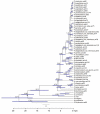Divergence and diversification in North American Psoraleeae (Fabaceae) due to climate change
- PMID: 19091055
- PMCID: PMC2646706
- DOI: 10.1186/1741-7007-6-55
Divergence and diversification in North American Psoraleeae (Fabaceae) due to climate change
Abstract
Background: Past studies in the legume family (Fabaceae) have uncovered several evolutionary trends including differential mutation and diversification rates across varying taxonomic levels. The legume tribe Psoraleeae is shown herein to exemplify these trends at the generic and species levels. This group includes a sizable diversification within North America dated at approximately 6.3 million years ago with skewed species distribution to the most recently derived genus, Pediomelum, suggesting a diversification rate shift. We estimate divergence dates of North American (NAm) Psoraleeae using Bayesian MCMC sampling in BEAST based on eight DNA regions (ITS, waxy, matK, trnD-trnT, trnL-trnF, trnK, trnS-trnG, and rpoB-trnC). We also test the hypothesis of a diversification rate shift within NAm Psoraleeae using topological and temporal methods. We investigate the impact of climate change on diversification in this group by (1) testing the hypothesis that a shift from mesic to xeric habitats acted as a key innovation and (2) investigating diversification rate shifts along geologic time, discussing the impact of Quaternary climate oscillations on diversification.
Results: NAm Psoraleeae represents a recent, rapid radiation with several genera originating during the Pleistocene, 1 to 2 million years ago. A shift in diversification rate is supported by both methods with a 2.67-fold increase suggested around 2 million years ago followed by a 8.73-fold decrease 440,000 years ago. The hypothesis that a climate regime shift from mesic to xeric habitats drove increased diversification in affected taxa was not supported. Timing of the diversification rate increase supports the hypothesis that glaciation-induced climate changes during the Quaternary influenced diversification of the group. Nonrandom spatial diversification also exists, with greater species richness in the American Southwest.
Conclusion: This study outlines NAm Psoraleeae as a model example of a recent, rapid radiation. Diversification rate shifts in NAm Psoraleeae are not due to current climate regimes as represented by habitat, but instead to past global climate change resulting from Quaternary glaciations. NAm Psoraleeae diversification is a good example of how earthly dynamics including global climate change and topography work together to shape biodiversity.
Figures


References
-
- Lewis G, Schrire BP, MacKinder B, Lock M. Legumes of the World. Kew: Royal Botanic Gardens; 2005.
-
- Magallon S, Sanderson MJ. Absolute diversification rates in angiosperm clades. Evolution. 2001;55:1762–1780. - PubMed
-
- Sanderson MJ, Wojciechowski MF. Diversification rates in a temperate legume clade: Are there 'so many species' of Astragalus (Fabaceae)? Am J Bot. 1996;83:1488–1502. doi: 10.2307/2446103. - DOI
-
- Wojciechowski M, Sanderson MJ, Baldwin BG, Donoghue MJ. Monophyly of aneuploid Astragalus (Fabaceae): evidence from nuclear ribosomal DNA-ITS sequences. Am J Bot. 1993;80:711–722. doi: 10.2307/2445441. - DOI
Publication types
MeSH terms
Substances
LinkOut - more resources
Full Text Sources
Other Literature Sources
Miscellaneous

